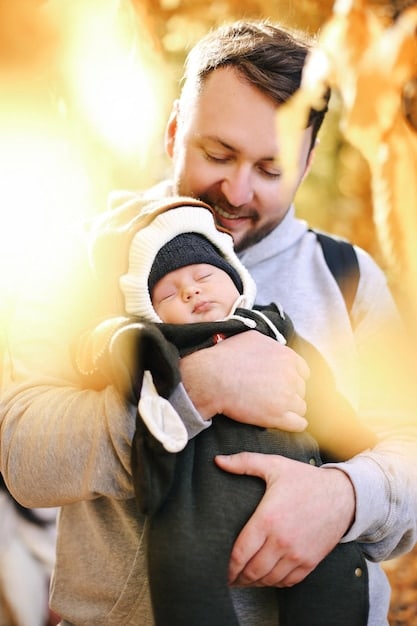Decoding Infant Cues: A Parent’s Guide to Understanding Your Baby’s Needs in the First 6 Months

Understanding nuanced infant cues, from hunger signals to sleep readiness, is crucial for new parents to effectively meet their baby’s needs and foster healthy development during the critical first six months of life.
Navigating the early months of parenthood can be both profoundly rewarding and undeniably challenging. Among the myriad of new responsibilities, learning to understand your baby’s unique language of cues is perhaps the most fundamental. This guide aims to demystify the process of decoding infant cues: a parent’s guide to understanding your baby’s needs in the first 6 months, transforming guesswork into confident care.
The Silent Symphony: Why Understanding Cues Matters
From the moment they arrive, infants communicate a continuous stream of information. They don’t use words, but their bodies, sounds, and facial expressions create a complex “silent symphony” of needs and emotions, especially during the crucial first six months. Recognizing and responding to these cues promptly is not just about meeting immediate demands; it builds a foundation of trust, security, and responsive attachment between parent and child.
During these early months, a baby’s brain is undergoing rapid development, forming billions of neural connections. Each interaction, each response to a perceived need, contributes to this intricate sculpting process. When a parent accurately decodes a cue—be it hunger, discomfort, or a need for connection—and responds appropriately, the baby learns that their world is predictable and safe. This consistency reinforces a sense of security, which is vital for emotional regulation and cognitive growth. Conversely, missed or misinterpreted cues can lead to frustration for both baby and parent, potentially impacting the bond and the baby’s developing sense of self-efficacy.
The Language of Early Infancy
Infants communicate through a repertoire of actions and sounds that evolve over time. Initially, these cues might seem subtle or ambiguous, making it challenging for new parents to distinguish between them.
- Universal Cries: While cries generally indicate distress, their intensity, pitch, and duration can vary. A sharp, urgent cry might signify hunger, while a whiny, lower-pitched cry could suggest tiredness.
- Body Language: A baby’s posture, limb movements, and facial expressions are rich sources of information. Clenched fists, arching backs, or restless movements are often signs of discomfort or overstimulation.
- Vocalizations beyond Crying: Early coos, grunts, and sighs, though not yet words, are attempts at communication and often indicate contentment or engagement.
Observing these combined signals rather than focusing on one in isolation provides a more comprehensive picture of the baby’s state. Building observational skills takes practice, patience, and a willingness to learn through trial and error. This initial period of deciphering lays the groundwork for more complex communication as the child grows.
Understanding these early cues enables parents to be proactive rather than reactive. Instead of waiting for a full-blown meltdown, recognizing early hunger cues allows for feeding before extreme fussiness escalates. Recognizing signs of tiredness can facilitate a smoother transition to sleep. This proactive approach reduces stress for both parent and child, fostering a more harmonious environment.
Moreover, a baby’s cues can sometimes be contradictory, or multiple cues might appear simultaneously. For instance, a baby might be hungry but also sleepy. In such cases, prioritizing needs often involves addressing the most immediate or pressing discomfort first. This complex interplay underscores the depth of understanding required from parents. It’s a continuous learning curve, adapting as the infant grows and their communication methods refine.
Decoding Hunger Cues: Beyond the Cry
Hunger is often the most common and urgent need of a newborn, and babies have a sophisticated way of signaling it before resorting to a full-blown cry. Recognizing these early hunger cues is paramount, as waiting until the baby is screaming can make feeding more challenging and stressful for everyone involved. Early cues indicate that the baby is ready to eat and often results in a more relaxed and effective feeding session.
The progression of hunger cues typically follows a pattern from subtle to overt. In the earliest stages, a baby might exhibit very gentle signs that can easily be missed by an untrained eye. As hunger intensifies, these cues become more pronounced, eventually leading to distress.
Early Hunger Signals
At the very first hint of hunger, a baby often shows signs that are easy to misinterpret for general wakefulness or mild fussiness. These are the optimal times to begin a feeding, as the baby is calm and receptive.
- Rooting: This reflex involves the baby turning their head towards anything that strokes their cheek or mouth, opening their mouth, and attempting to suck. It’s a clear indication they are searching for a nipple.
- Lip Smacking/Sucking Motions: Babies may make smacking sounds with their lips or begin to suck on their hands, fingers, or anything else that comes near their mouth. This is a practice run for feeding.
- Increased Alertness/Activity: While still calm, the baby may become more alert, open their eyes wide, and seem generally more “aware” and active, signaling a readiness to engage with feeding.
Observing these subtle signs helps parents preempt the escalation of hunger. When a baby is exhibiting these early cues, they are typically easier to latch for breastfeeding or more willing to accept a bottle, leading to a more positive feeding experience. It also fosters a sense of responsiveness, teaching the baby that their needs are quickly met, enhancing trust.

Mid and Late Hunger Cues
If early hunger cues are missed, the baby will progress to more obvious and distressed signals. These indicate a higher level of hunger and often a state of frustration.
- Fussiness and Restlessness: The baby begins to squirm, fuss, and move around, exhibiting general discomfort. Their movements might be jerky or agitated.
- Turning Head Vigorously: Instead of gentle rooting, the head movements become more frantic, often accompanied by agitated sounds.
- Crying: This is the late hunger cue. A baby crying for hunger is often inconsolable until fed. Their cry might be sharp, urgent, and intense. Feeding a baby who is already crying can be challenging, as they may gulp air, leading to gas and further discomfort. It might also be harder for them to latch effectively.
It is always ideal to feed a baby before they reach the crying stage. By recognizing and responding to early and mid-stage cues, parents can prevent their baby from becoming overly distressed. This makes feedings smoother and more enjoyable for both the baby and the caregiver, reinforcing a positive association with nourishment and care. Understanding that a baby’s cries are a last resort for communication emphasizes the importance of vigilance regarding earlier signals.
Every baby is unique, and while these general patterns hold true, the specifics of how a baby expresses hunger may vary. Consistent observation and knowing your baby’s individual patterns are key. Maintaining a feeding log in the initial weeks can also help create a visual record of feeding times and the cues that preceded them, offering valuable insights into individual hunger rhythms.
Sleepy Signals: Easing into Rest
Sleep is a fundamental need for infants, crucial for their rapid development and growth. Just as with hunger, babies communicate their need for rest through a series of increasingly obvious cues. Recognizing these sleepy signals early allows parents to initiate a soothing sleep routine before their baby becomes overtired, which often leads to fussiness and difficulty falling asleep. An overtired baby can be harder to settle, resulting in shorter naps and more disrupted nighttime sleep.
The progression of sleepy cues often mirrors the escalation seen with hunger cues: starting subtly and becoming more pronounced as the baby becomes more fatigued. Learning to distinguish true sleepy cues from other forms of fussiness is a skill that develops with observation and practice.
Early Sleepiness Indicators
Catching these early signs gives parents the best window to prepare their baby for sleep, ensuring a smoother transition and more restorative rest. These cues often appear before deep yawns or heavy eyelids.
- Yawning: One of the most classic and straightforward signs, yawning indicates that the baby’s body is signaling a need for more oxygen, often associated with a sleepy state.
- Rubbing Eyes/Ears: Babies might rub their eyes vigorously or tug at their ears as a self-soothing mechanism when they are tired. This can sometimes be accompanied by a slight redness around the eyes.
- Gazing into Space/Less Focused: A baby who was previously engaged with their surroundings might start to lose interest, staring blankly or having a softer, less focused gaze. Their movements might become slower or less purposeful.
Responding to these early cues is vital for establishing healthy sleep habits. When a baby is put down for sleep while just drowsy (and not already overtired), they have a better chance of learning to self-soothe and fall asleep independently. This proactive approach helps to avoid the “second wind” phenomenon, where an overtired baby suddenly seems more awake and energetic, making it even harder to get them to sleep.
Creating a consistent pre-sleep routine, even a simple one like dimming the lights, singing a lullaby, or a brief cuddle, can help reinforce these sleepy cues and signal to the baby that sleep is approaching. This predictability provides comfort and security.
Overtiredness and Late Sleep Signals
Missing the early signs of sleepiness can lead to a baby becoming overtired, a state characterized by increased fussiness and difficulty settling down for sleep. This is often when parents observe more advanced and distressing cues.
- Increased Fussiness/Crying: An overtired baby may become irritable, whiny, or start to cry incessantly. Their cries might seem frantic or inconsolable, indicating extreme discomfort or exhaustion.
- Arching Back/Stiffening Body: As a baby struggles to cope with overstimulation and fatigue, they might arch their back, stiffen their limbs, or push away from the caregiver. These are signs of distress and discomfort.
- Hyperactivity/”Second Wind”: Paradoxically, some overtired babies may appear more alert and energetic, exhibiting bursts of restless movement or heightened activity. This is the body’s stress response trying to fight off sleep, making it incredibly challenging to get them to settle.
When a baby reaches these late sleep signals, it can be significantly harder to get them to calm down and fall asleep. They might fight sleep, refuse to nap, or wake frequently during the night. Recognizing the trajectory from early yawns to frantic cries helps parents intervene effectively. Sometimes, simply taking the baby to a quiet, dimly lit room and offering a comforting cuddle can be enough to de-escalate the situation and encourage sleep.
Understanding these sleep cues is an integral part of responsive parenting. It allows for the establishment of more predictable sleep patterns and contributes positively to the baby’s overall well-being and developmental trajectory. Every baby’s sleep needs vary, so consistent observation and flexibility are key.
Comfort and Contentment: When All is Well
While much of parental focus often gravitates towards decoding signals of distress or unmet needs, it is equally important to recognize and appreciate when a baby is comfortable, content, and thriving. These positive cues provide reassurance to parents and indicate that the baby’s environment is supportive and enriching. Understanding these signs not only alleviates parental anxiety but also reinforces responsive caregiving, encouraging more of what is working well. A content baby is typically one whose fundamental needs—hunger, sleep, warmth, and connection—are being met effectively.
When an infant is in a state of comfort, their communication shifts from urgent demands to more subtle expressions of pleasure and engagement. These moments are crucial for fostering secure attachment and promoting healthy social and emotional development. It’s during these periods that babies are most receptive to learning and interaction, forming the basis of joyful parent-child connection.
Signs of Contentment and Well-being
A baby who feels secure and satisfied will exhibit a range of positive behaviors that signify their overall well-being.
- Soft, Relaxed Body: The baby’s limbs will be relaxed, not stiff or tense. Their hands might be open or gently curled, rather than clenched into fists. Their posture is generally easygoing and without signs of discomfort.
- Smooth, Quiet Breathing: Breathing is regular, calm, and relatively quiet, indicating no respiratory distress or intense crying.
- Alert and Engaged: The baby’s eyes are open and bright, making eye contact and actively tracking faces or objects. They show curiosity about their surroundings, turning their head to observe new sights or sounds.
- Cooing and Gurgling Sounds: These sweet, soft vocalizations are often a sign of pleasure and engagement. They indicate that the baby is happy and attempting to “converse” with their caregivers.
- Happy Facial Expressions: Subtle smiles, wide-eyed wonder, or a generally serene expression are clear indicators of contentment. Even a slightly parted mouth or relaxed lips can suggest comfort.
These signs signal that the baby is in a “quiet alert” state, which is optimal for learning and interaction. During these times, parents can engage in gentle play, read stories, or simply enjoy quiet cuddles. These interactions contribute significantly to a baby’s cognitive and emotional development, as they absorb information and build social connections. Recognizing these moments of calm also allows parents to take a moment to enjoy their baby’s presence without the pressure of addressing an immediate need, fostering a deeper bond.
It’s important to remember that even a content baby will still have periods of fussiness or unmet needs. However, an overall pattern of contentment indicates a responsive care environment. Parents should also observe typical behavior for their individual child, as what constitutes “content” can vary slightly from one infant to another. For example, some babies might be naturally more vocal, while others express contentment through calm stillness.
Celebrating these moments of calm and happiness reinforces the positive aspects of parenting and helps build parental confidence. It reminds caregivers that their efforts are effective and that their baby is indeed thriving under their care. These periods of contentment are not merely the absence of distress; they are active states of well-being that are essential for healthy development.

Distress and Discomfort: Beyond Basic Needs
While hunger, sleep, and the need for comfort are primary drivers of infant cues, babies also communicate various forms of distress and discomfort that go beyond these basic requirements. Understanding these more nuanced signals is crucial for identifying underlying issues such as illness, overstimulation, or digestive problems. Misinterpreting these cues can lead to prolonged discomfort for the baby and increased frustration for parents. Effective decoding requires keen observation and often, a process of elimination.
Infant discomfort can stem from a multitude of sources, ranging from a simple wet diaper to more complex issues like gas, teething pain, or even the early signs of an infection. Each type of discomfort may elicit a slightly different set of cues, though some overlap is common. The key is to differentiate general fussiness from specific pain or unease, leading to appropriate intervention.
Common Manifestations of Discomfort
Babies articulate their discomfort through specific vocalizations, body movements, and changes in their physical state. Recognizing these patterns helps in pinpointing the source of their unease.
- Pain/Illness Cries: Unlike hunger cries, pain cries often sound sharp, high-pitched, and continuous, sometimes with sudden, piercing screams. A cry associated with illness might be weaker, whiny, or more persistent, indicating general malaise.
- Body Stiffness/Arching Back: This is a common sign of digestive discomfort (like gas or reflux). The baby might pull their legs up towards their belly, stiffen their body, or vigorously arch their back away from the caregiver.
- Facial Expressions of Pain: A baby in pain might furrow their brow, clench their jaw, or have tightly closed eyes. Their face might appear strained or contorted.
- Unusual Sleep Patterns: Significant changes in sleep, such as extreme restlessness during sleep, frequent waking with cries of discomfort, or an unusual amount of sleepiness, could signal illness or discomfort.
- Changes in Eating Habits: A sudden refusal to feed, or dramatically reduced intake, can indicate discomfort. This is often accompanied by other signs of illness.
When these signs are observed, parents should systematically check for common sources of discomfort: a wet or soiled diaper, temperature (too hot or too cold), clothing discomfort, or an urge to burp. If these simple remedies don’t alleviate the distress, focusing on more specific causes becomes necessary. For instance, an infant with gas might benefit from bicycle leg movements or gentle tummy massage, while a baby cutting a tooth might find relief from a cold teether.
It is important to remember that persistent, inconsolable crying, especially when accompanied by fever, unusual lethargy, or changes in feeding/digestive patterns, warrants immediate medical attention. Parents should trust their instincts when they feel something isn’t right, as they know their baby best.
Responding to Overstimulation
Infants, particularly newborns, are easily overwhelmed by too much sensory input. A noisy environment, bright lights, too many people, or excessive handling can lead to overstimulation, manifesting as discomfort or distress.
- Turning Away Head/Gaze Aversion: The baby might actively avert their gaze, turn their head away from the source of stimulation, or close their eyes. This is their way of saying, “I’ve had enough.”
- Fussiness/Irritability: They may become increasingly fussy, agitated, or start to cry. Unlike hunger or pain cries, this might be accompanied by attempts to “shut down” from the environment.
- Disorganized Movements: Jerky, spastic movements or flailing limbs without purpose can be a sign of their nervous system being overwhelmed.
- Frequent Yawning/Falling Asleep: Some babies cope with overstimulation by “checking out” and falling asleep, often very quickly, even if they weren’t previously tired. This is a protective mechanism.
Recognizing overstimulation cues allows parents to intervene by removing the baby from the stimulating environment, offering a quiet space, dimming lights, and reducing noise. Providing calm, consistent comfort can help the baby regulate their emotions and nervous system. This understanding underlines the importance of creating a balanced environment for infants, respecting their limits for sensory input, and providing opportunities for quiet downtime, particularly for newborns whose nervous systems are still maturing.
Ultimately, decoding distress and discomfort cues is a critical component of responsive care. It enables parents to move beyond guesswork, offer targeted relief, and ensure their baby’s well-being is maintained across all circumstances. Patience, close observation, and trusting one’s parental intuition are invaluable tools in this delicate process.
Bonding and Attachment: The Language of Connection
Beyond meeting physiological needs, infants have a profound need for connection and emotional security. This need for bonding and attachment is communicated through a unique set of cues that invite interaction and reinforce the parent-child relationship. Recognizing these “connection cues” is just as vital as understanding hunger or sleepy signals, as they lay the groundwork for healthy emotional development and a secure sense of self. During the first six months, these reciprocal interactions are the foundation of a strong, enduring bond.
Attachment is not a one-sided process; it’s a dynamic dance between parent and child. When a baby makes an effort to connect, and the parent responds warmly and consistently, a secure attachment forms. This secure base allows the child to explore their world confidently, knowing they have a safe harbor to return to. These early interactions shape a baby’s understanding of relationships, trust, and their place in the world.
Cues for Connection and Engagement
Babies signal their desire to connect through various charming and sometimes subtle behaviors. These are the moments when they are most open to social interaction and emotional exchange.
- Eye Contact: Direct, sustained eye contact is a powerful cue for connection. When a baby meets your gaze and holds it, they are inviting interaction and expressing a desire to engage.
- Social Smile: Around 6-8 weeks, babies begin to offer social smiles—smiles that are in response to a parent’s voice or face. These are genuine expressions of joy and connection, distinct from reflexive smiles.
- Cooing, Gurgling, and Babbling: Early vocalizations that aren’t cries are often attempts at communication. When a baby coos or babbles in response to your voice, they are participating in a conversation, signaling their desire to connect. This is often reciprocal, as parents naturally respond in kind.
- Reaching Out/Lifting Arms: As they gain motor control, babies might reach out their arms, especially when they want to be picked up or held close. This is a direct invitation for physical comfort and closeness.
- Following with Gaze: A baby who actively tracks a parent’s movements or face with their eyes is expressing interest and a desire to remain connected to their caregiver’s presence.
Responding to these engagement cues creates a positive feedback loop. When a parent smiles back, mirrors vocalizations, or offers a comforting touch, the baby learns that their attempts at connection are valued and reciprocated. This strengthens the attachment bond and builds the baby’s confidence in their ability to influence their environment and connect with others. These interactions are not just cute; they are critical building blocks for social intelligence and emotional regulation. Shared moments of joy and quiet connection foster a sense of belonging and love.
Seeking Comfort and Reassurance
Beyond active engagement, babies also signal their need for comfort, reassurance, or a sense of security, especially when feeling overwhelmed, anxious, or just needing a sense of presence.
- Cuddling In: When held, a baby might snuggle deeply into the caregiver’s chest, head resting against them, indicating a desire for close physical comfort and security.
- Content Sighs: After a period of crying or fussiness, a deep, relaxed sigh often indicates relief and comfort upon being held or soothed. It’s a sign they are settling into a secure space.
- Looking for Parent’s Face/Voice in Distress: Even during moments of discomfort, a baby might search for their parent’s face or quiet when they hear their parent’s voice, indicating that the mere presence of the caregiver provides reassurance.
- Falling Asleep While Held: Often, a baby who has been fussy or overstimulated will easily fall asleep in a parent’s arms, signaling that the contact provides the ultimate comfort and safety.
Responding to these cues for comfort reinforces the baby’s understanding that their caregivers are a source of solace and protection. This builds trust and resilience. The consistency of these responses teaches the baby that the world, while sometimes overwhelming, is ultimately a safe place because their needs for connection and comfort are reliably met. This secure attachment is a protective factor throughout childhood, influencing social relationships and emotional well-being.
Understanding the language of connection is perhaps the most rewarding aspect of decoding infant cues. It transforms the act of caregiving into a rich, interactive relationship, foundational for a child’s healthy development and a joyful parenting journey.
When to Seek Professional Guidance
While parents become increasingly adept at decoding their baby’s cues, there are instances when a baby’s communication signals something beyond typical infant needs. Knowing when to seek professional guidance from a pediatrician or other healthcare provider is crucial for ensuring the baby’s well-being and addressing potential underlying issues. Trusting parental instincts is key, and no concern is too small to discuss with a medical professional, especially during the critical first six months of life.
Many common infant issues can be managed at home with responsive care. However, certain cues or patterns of behavior can indicate a more serious condition that requires medical attention. Early intervention can make a significant difference in outcomes for many health challenges.
Red Flag Cues Requiring Medical Attention
These cues often indicate a deviation from normal infant behavior and should prompt a call or visit to your pediatrician.
- Persistent, High-Pitched Crying: While all babies cry, inconsolable, high-pitched, or screaming cries that last for extended periods (especially several hours) and cannot be soothed by typical comfort measures (feeding, changing, cuddling) can be a sign of significant pain or illness.
- Lethargy or Unresponsiveness: A baby who is unusually sleepy, difficult to wake for feedings, or unresponsive to stimulation (not making eye contact, not reacting to sounds/touch) needs immediate medical evaluation. This is a particularly concerning sign in newborns.
- Difficulty Breathing: Signs such as rapid breathing, flared nostrils, grunting sounds with each breath, retractions (skin pulling in between ribs or above collarbones with each breath), or blue discoloration around the mouth or fingernails are medical emergencies.
- Fever: For infants under 3 months, any fever (rectal temperature of 100.4°F / 38°C or higher) warrants immediate medical attention. For infants over 3 months, a high fever or one accompanied by other concerning symptoms should be evaluated.
- Poor Feeding/Dehydration Signs: A significant decrease in feeding frequency or volume, fewer wet diapers than usual (less than 6 in 24 hours for older infants, or less than 1 every few hours for newborns), dry mouth, sunken soft spot (fontanelle), or lack of tears when crying can indicate dehydration, which is serious for infants.
- Forceful Vomiting/Projectile Vomiting: While spitting up is common, vomiting that is forceful, occurs repeatedly, or is green/yellow in color needs prompt medical assessment.
- Infrequent Stool or Unusual Stool: Persistent constipation (fewer than one stool every several days, especially if hard and causing distress) or stools that are white, black (after the first few days), or contain blood should be discussed with a doctor.
It is always better to err on the side of caution when it comes to an infant’s health. If something feels “off” to a parent, seeking professional advice is the most responsible course of action. Pediatricians are accustomed to parents calling with concerns that may seem minor; they understand the importance of early detection and reassurance.
General Concerns and Developmental Milestones
Beyond acute illness, there are also times when a parent might seek guidance regarding developmental milestones or persistent behavioral patterns.
- Concerns about Growth and Weight Gain: If a baby is not gaining weight adequately despite frequent feedings, or if there are concerns about their growth curve, professional advice is important to rule out feeding issues or underlying health conditions.
- Persistent Colic-like Symptoms: While colic is common, if crying spells are consistently severe, prolonged, and disruptive, a doctor can help rule out other causes of discomfort or offer strategies for managing symptoms.
- Lack of Expected Developmental Milestones: By 6 months, babies typically show certain developmental progress (e.g., holding their head steady, reaching for objects, social smiling, babbling). If a baby seems significantly behind in these areas, or if there are concerns about vision or hearing, consultation with a pediatrician is warranted.
- Feeding Difficulties: If breastfeeding is consistently painful, if the baby struggles to latch, or if bottle-feeding results in significant fussiness or gas, a lactation consultant or pediatrician can provide valuable support.
Regular well-baby check-ups are specifically designed for monitoring these aspects of a baby’s health and development and provide a consistent opportunity to raise any questions or concerns. These appointments are not just for vaccinations but for comprehensive assessments of the baby’s overall well-being. Keeping a log of feeding, sleep, and notable cues can also be helpful information to share with your healthcare provider during these visits. Ultimately, open communication with your pediatrician is key to ensuring your baby receives the best possible care as they grow and develop.
| Key Area | Brief Description |
|---|---|
| 🍼 Hunger Cues | Early signs include rooting, lip smacking; late cues involve fussiness and crying. Feeding proactively is best. |
| 😴 Sleep Signals | Look for yawning, eye rubbing; overtired babies may become fussy or hyperactive. Initiate sleep routine early. |
| 😌 Contentment | Indicated by relaxed body, eye contact, cooing, and social smiles. These are optimal times for interaction. |
| 🩺 Red Flags | Persistent high-pitched crying, lethargy, fever in infants under 3 months require immediate medical attention. |
Frequently Asked Questions About Infant Cues
Hunger cries often start as smacking or rooting, escalating to a repetitive, urgent cry, often accompanied by sucking motions. Discomfort cries, such as for gas or pain, might be more high-pitched, piercing, or whiny, and your baby may arch their back or pull legs to their chest if it’s tummy-related. Observing preceding cues helps differentiation.
A “second wind” means your baby has gone past their optimal sleep window and their body is producing stimulating hormones like cortisol to fight off sleep. This results in them appearing more energetic or suddenly becoming very fussy and difficult to settle. Recognizing early sleepy cues is essential to avoid this stage.
To soothe an overstimulated baby, try moving to a quiet, dimly lit room. Reduce sensory input by dimming lights, lowering noise, and swaddling if appropriate for their age. Offer calm, consistent comfort like gentle rocking or holding close. Sometimes, simply removing them from the stimulating situation is enough to help them regulate.
You should contact a doctor if your baby’s crying is inconsolable, high-pitched, or unusually weak, especially if accompanied by a fever (100.4°F/38°C or higher for infants under 3 months), lethargy, difficulty breathing, or signs of dehydration. Trust your parental instincts if something feels genuinely wrong.
Accurately understanding and responding to infant cues builds trust and a secure attachment. When a baby’s needs are consistently met, they feel safe and understood, fostering a deep emotional connection. This responsive interaction creates a foundation of security, which is crucial for their emotional and social development.
Conclusion
The journey of parenthood, particularly during the first six months, is profoundly shaped by the ability to interpret the intricate language of infant cues. Far more than just meeting immediate needs, this ongoing decoding process builds a robust foundation of trust, security, and reciprocal attachment. From the first subtle hunger signals to the cries of deep distress, each cue offers a unique insight into your baby’s physical and emotional world. By cultivating keen observational skills, maintaining patience, and trusting your innate parental intuition, you transform guesswork into confident, responsive care. This continuous learning, adapting to your baby’s evolving expressions, not only ensures their well-being but also deepens the invaluable bond between parent and child, paving the way for healthy development and a joyous shared experience.





